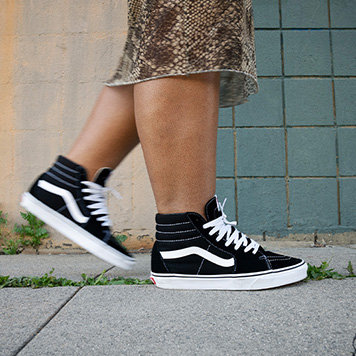
How are Vans shoes made?

- Style

Ever wondered how your favourite pair of Vans made it from the factory floor to your feet? We explore Vans’ time-tested manufacturing process, which sees every shoe crafted by up to 450 pairs of hands.
Vans’ history stretches back to 1966 when brothers Paul and Jim Van Doren – along with friends Gordy and Serge – opened the doors to the Van Doren Rubber Company at 704 East Broadway in Anaheim, California. Paul’s 20-year career at Randy’s, a shoe factory in his native Boston, had given him the industry know-how needed to build his own shoe brand from the ground up.

Vans’ original manufacturing and fulfilment process was simple: employees made rubber-soled shoes each morning and sold them straight out of the company’s Anaheim factory in the afternoon.
Over the next 30 years, Vans shoes were made out of several factories in California until the company’s manufacturing operations were moved to China and Vietnam in the late ‘90s.
What material are Vans made of?
One of Vans shoes’ signature features is their vulcanised rubber construction, which is praised by skaters for its superior grip and support while on the board.
Vulcanised rubber is unique in that it goes through two stages of ‘baking’: rubber is cured by heat and compressed, then a second ‘steam baking’ takes place after assembly to ensure a durable yet easy-to-break-in shoe.

The original method of vulcanisation, which is still the most common, is to mix sulphur with natural rubber before heating it. The sulphur changes the chemical composition of the rubber, creating crosslinks between polymers to make the resulting material stronger and more long-lasting.
One of the earliest uses of vulcanised rubber took place in 1876 when a company in the UK began making rubber-soled plimsolls designed for croquet. Since its inception in the late 1800s, vulcanisation has become a widely used technique, and most rubber products sold today are vulcanised.
Synthetic materials like EVA foam and lightweight nylon can’t be used in vulcanised shoes as they tend to melt during the vulcanising process. That’s why fabrics like canvas and suede – which can withstand the high heat during manufacturing – are used as uppers for Vans shoes.

What is Vans’ manufacturing process?
Today, Vans makes between 70 and 85 million pairs of shoes every year, with every pair worked on or inspected by up to 450 people. Although operations are done on a vastly larger scale than they were in the early days, the signature manufacturing process has remained much the same.

Each pair of Vans shoes goes through a five-step production process:
- The first stage of vulcanising takes place at the rubber room, the birthplace of each sneaker’s signature waffle sole. Here, rubber is cured by heat before being compressed.
- Shoe soles are ‘hole-punched’ out of the compressed rubber.
- Soles are pressed into a criss-cross shape to create the iconic waffle sole.
- Shoes move into the assembly room, where the uppers and detailing of the shoes are selected and applied. Most of the shoe’s appearance is created at this stage, where a stitched canvas or suede panel is tightly fitted around a mould to create a sturdy upper and detailing is applied. Three rubber strips called ‘foxing' are then applied over the upper and sole before the excess rubber outsole is trimmed and the Vans logo is placed at the heel.
- Shoes are lacquered before entering the vulcanising oven, where the ideal heat, pressure and humidity conditions harden the shoe to complete its construction.
Once the manufacturing process is complete, the shoes are ready to be boxed or can be printed onto, depending on the style.
How long do Vans Customs take?
Vans prints custom patterns, photos and designs onto all iconic styles, including the Old Skool, Authentic, Slip-On, Era and Sk8-Hi. In 2017, Vans unveiled a new, innovative machine that allows custom designs to be printed on to shoes in less than 15 minutes.
Vans vice-president of creative Jamie Reilly told Fast Company that the new customisation machine allows Vans devotees to express themselves, which has always been a key focus for the brand.
“The checkerboard is an iconic piece of Vans branding but it originally came from kids drawing on their shoes,” Reilly said. “So this is just another cool way we can see what people want. The new machine fits into this as just another experiment to help us connect better with our customers and give them another platform for their own creativity and expression.”
Vans’ tradition for making custom shoes goes back to our beginnings in California in the ‘60s. As the story goes, a customer walked into the shop on the very first day and asked for shoes in a colour which wasn’t then available. Paul Van Doren told her:
“Bring me the fabric you want your shoes made out of and I’ll make them for an extra 50 cents.”
The rest, as they say, is history.



